Global Aluminum Production in 2023: Key Trends and Regional Contributions Analyzed
The global aluminum industry plays a pivotal role in modern manufacturing, construction, and transportation sectors. In 2023, aluminum smelter production was a key indicator of industrial activity, with several countries contributing significantly to the worldwide output. According to estimates from the United States Geological Survey (USGS) published in 2024, the total production was distributed across major producing nations, including Norway, Australia, Canada, Brazil, India, the United Arab Emirates (UAE), and the rest of the world.

This article delves into the specifics of aluminum smelter production in 2023, examining regional contributions, trends, and the broader implications for the global market.
Norway: A Leading Producer with Dual Output Figures
Norway emerged as one of the top contributors to global aluminum smelter production in 2023, with reported outputs of 1.6 million tonnes and 3.8 million tonnes. The significant variance between these figures suggests the presence of multiple smelting facilities or potential discrepancies in reporting methodologies. Norway’s robust aluminum industry is supported by abundant hydroelectric power, which provides a cost-effective and sustainable energy source for energy-intensive smelting processes. The country’s commitment to green energy aligns with the increasing global demand for sustainably produced aluminum, particularly in industries prioritizing carbon footprint reduction.
Australia: Steady Production with Moderate Growth
Australia’s aluminum smelter production in 2023 was recorded at 1.3 million tonnes and 1.5 million tonnes. These figures indicate a stable yet modest contribution compared to other leading producers. Australia’s aluminum industry benefits from its vast bauxite reserves, the primary raw material for aluminum production. However, challenges such as energy costs and environmental regulations have influenced production levels. Despite these hurdles, Australia remains a critical player in the global supply chain, particularly for Asian markets.
Canada: A Strong Contender with Significant Output
Canada reported a production of 3 million tonnes in 2023, solidifying its position as a major aluminum producer. The country’s smelting capabilities are concentrated in Quebec, where access to renewable hydroelectric power ensures competitive production costs. Canada’s aluminum is highly sought after in North American automotive and aerospace industries, where high-quality, lightweight materials are essential. Additionally, Canada’s focus on low-carbon aluminum production enhances its appeal in environmentally conscious markets.
Brazil: Consistent Production with Room for Expansion
Brazil’s aluminum smelter production in 2023 stood at 1.1 million tonnes and 1.5 million tonnes, reflecting a consistent output. The country’s aluminum industry is supported by abundant bauxite reserves and a growing emphasis on renewable energy sources. However, infrastructural limitations and economic fluctuations have occasionally hindered production scalability. Despite these challenges, Brazil remains a key supplier to both domestic and international markets, particularly in South America.
India: Emerging as a Global Leader
India’s aluminum production reached an impressive 4.1 million tonnes in 2023, highlighting its rapid industrial growth. The country’s smelting capacity has expanded significantly in recent years, driven by increasing domestic demand and government initiatives to boost manufacturing. India’s aluminum industry benefits from cost-effective labor and growing investments in energy infrastructure. This growth positions India as a formidable competitor in the global aluminum market, with potential to further increase its share in the coming years.
UAE: A Notable Contributor with a Single Output
The United Arab Emirates reported a production of 2.7 million tonnes in 2023. The UAE’s aluminum industry is centered around the Emirates Global Aluminium (EGA) company, one of the largest producers of premium aluminum globally. The country’s strategic location and access to cheap energy resources, primarily from natural gas, provide a competitive edge. The UAE’s aluminum is widely exported to markets in Asia, Europe, and North America, reinforcing its role in global trade.
Rest of the World: Collective Contribution
The combined aluminum smelter production from the rest of the world totaled 9.5 million tonnes in 2023. This category includes numerous countries with smaller but collectively significant outputs. Regions such as Russia, China, and several African nations contribute to this segment, each with unique advantages and challenges. For instance, China’s dominance in primary aluminum production is well-known, though specific figures for 2023 were not isolated in this dataset. The rest of the world’s production underscores the decentralized nature of the global aluminum industry, with diverse players supporting worldwide demand.
Conclusion: Trends and Future Outlook
The 2023 aluminum smelter production data reveals a dynamic and geographically diverse industry. Norway and Canada stand out for their high production volumes and sustainable energy practices, while India’s rapid growth signals its rising prominence. Australia and Brazil maintain steady outputs, while the UAE leverages its energy resources to remain a key exporter. The rest of the world’s substantial collective production highlights the global reliance on aluminum for various applications.
Looking ahead, the aluminum industry is expected to face evolving challenges, including energy cost volatility, environmental regulations, and shifting trade policies. However, advancements in green smelting technologies and increasing demand for lightweight materials in renewable energy and electric vehicle sectors present significant growth opportunities. As nations continue to innovate and adapt, the aluminum smelter production landscape will remain a critical barometer of industrial and economic trends worldwide.
Sources: United States Geological Survey (2024), On X : Elements
Photo from: iStock
0 Comment to "Global Aluminum Production in 2023: Key Trends and Regional Contributions Analyzed"
Post a Comment